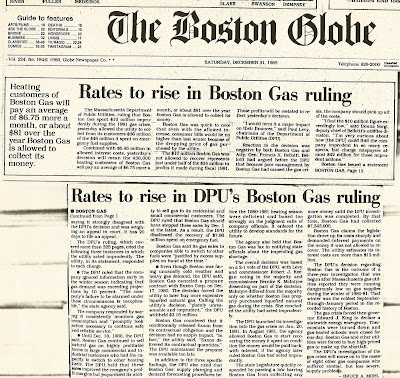Economists are so embedded in their training with the concept of
ceteris paribus -- "all other things held equal" -- that their policy prescriptions often go awry. Here are two recent examples:
First, in the March 10, 2011 issue of the
New England Journal of Medicine, David Cutler and Leemore Dafney
argue against transparency of pricing in the health care sector.
The rationale for price transparency is compelling. Without it, how can consumers choose the most efficient providers of care? But though textbook economics argues for access to meaningful information, it does not argue for access to all information. In particular, the wrong kind of transparency could actually harm patients, rather than help them.Applying the sunshine rule in the provider–payer context, however, could have the opposite of the intended effect: it could actually raise prices charged to patients.[T]he sunshine policy would create a perverse incentive for the hospital to raise prices (on average), and as a result its rivals could do the same. This adverse effect of price transparency would arise only in cases in which the buyer or supplier in question had some leverage (market power), but such leverage is fairly common in health care settings, including many local hospital markets.What's the flaw here? In markets like Eastern Massachusetts, there is a dominant provider which uses its market power to garner above average prices from the insurance companies in its service area. That provider, in turn, can use those revenues to offer higher salaries than its competitors, drawing doctors into its orbit. It also has more resources to expand its
ambulatory care facilities. Both steps serve to further expand its market power.
Then, that expanded referral base sends still more patients to the flagship tertiary hospitals. Those hospitals and the doctors therein are paid more than other hospitals in that area.
In short, the higher rates obtained in secret negotiations serve over time to increase the overall cost of care in such a region. In the absence of state rate-setting authority, a powerful way to put a break on this practice is to publish the rates paid by each insurer to each hospital and physician group. With no documented difference in the quality of care among providers, the publicity therein created creates sufficient moral authority for insurers to show some backbone in subsequent negotiations. It also creates the rationale for limited network insurance products, in which subscribers pay different premiums and co-pays for the option of using lower cost providers.
Would you like proof? Until the Attorney General
published the relative payments received in the Massachusetts market, the market-power driven system ruled in this state. It was only after her office demonstrated the inflationary effect of such a system that moves to equalize rates began
in earnest and
tiered products took hold.
Contrary to the point raised by Cutler and Dafney, the point of price transparency is not mainly to offer individual consumers information about provider choice. After all, the vast majority of people go to hospitals and specialists recommended by their primary care doctor. Price transparency creates general awareness among providers, insurers, and large business purchasers of the dynamics of the marketplace. This providers an umbrella for effective change.
Second, in the
New York Times, Paul Krugman today gets it wrong when he asserts that "
Medicare Saves Money".
The idea of Medicare as a money-saving program may seem hard to grasp. After all, hasn’t Medicare spending risen dramatically over time? Yes, it has: adjusting for overall inflation, Medicare spending per beneficiary rose more than 400 percent from 1969 to 2009.
But inflation-adjusted premiums on private health insurance rose more than 700 percent over the same period. So while it’s true that Medicare has done an inadequate job of controlling costs, the private sector has done much worse.And then there’s the international evidence. The United States has the most privatized health care system in the advanced world; it also has, by far, the most expensive care, without gaining any clear advantage in quality for all that spending. Health is one area in which the public sector consistently does a better job than the private sector at controlling costs. Here's where Mr. Krugman is wrong. The Medicare rates paid to doctors and hospitals are set by government fiat. They are based on Congressional appropriations, political decisions resulting from the give and take of the legislative process. Ditto for Medicaid rates set by the states. They have little or no relationship to the cost of providing service to patients. When there is a shortfall in Medicare and Medicaid revenues, the difference is made up by the rates paid by private insurers.
He is also wrong in comparing the US to other countries and asserting that the difference in costs is based on the difference between private and public systems. That difference is based on a variety of factors, of which public versus private is but one. For example, many national systems rightfully put a greater emphasis on primary care than the US. This is clearly cost-effective. But, it is the
Medicare-approved pricing system that overpays specialists relative to primary care doctors and other cognitive specialists -- not only for Medicare, but for private insurers, too.
Many other countries, too, provide free medical education to prospective doctors, reducing the salary needs of those professionals. Some countries, like Italy, allow virtually anyone to go to medical school, creating a surfeit of doctors, whose wages are then bid down.
Finally, of course, the national budgets for health care in public systems are -- like Medicare -- the result of governmental fiat that have had little or no relationship to the demand for health care services or the underlying cost of such services. As I have
noted,
[T]his appropriation by the parliament is a politically derived decision, just as it would be for any appropriation for a program of important national priority, and it therefore competes with other worthy national programs for resources.When the government doesn't want to pay for these services, what happens? A parallel, private system of doctors and insurance companies emerges.
But even there, nationalized system in other countries are starting to see
US-like cost pressures as demographic and political trends push them to offer greater levels of specialized tertiary care and facilities. The systems are
starting to converge:
I predict, though, that the systems will start to look more and more alike over time. Pressure in the US for a more nationally-determined approach. Pressure in Europe for more of a private market approach. It shouldn't surprise us to see this convergence. After all, the countries are dealing with the same organisms, both biologically and politically. So, Mr. Krugman,
ceteris paribus doesn't apply here. Nothing else is held equal when it comes to comparing health care systems.
(By the way, I agree with his conclusion that raising the Medicare eligibility age from 65 to 67 does not make sense, but that's for other reasons.)
 In the post below, I summarize a conference held today at Jeroen Bosch Hospital in 's-Hertogenbosch (den Bosch), in the Netherlands, entitled "Quality and Transparency in Care and Training." In addition to the conference, today was a significant day in that a new website was launched by the hospital to present quality and safety data to the public and to the hospital's staff.
In the post below, I summarize a conference held today at Jeroen Bosch Hospital in 's-Hertogenbosch (den Bosch), in the Netherlands, entitled "Quality and Transparency in Care and Training." In addition to the conference, today was a significant day in that a new website was launched by the hospital to present quality and safety data to the public and to the hospital's staff. As explained by Dr. Marjo Jager, patient quality specialist, Jeroen Bosch has a strong commitment to transparency as a key element of process improvement in the hospital. The leadership of the hospital views transparency as the most powerful way to reduce preventable injuries, but also as essential to successful and ethical responses to patients and to safeguard employees.
As explained by Dr. Marjo Jager, patient quality specialist, Jeroen Bosch has a strong commitment to transparency as a key element of process improvement in the hospital. The leadership of the hospital views transparency as the most powerful way to reduce preventable injuries, but also as essential to successful and ethical responses to patients and to safeguard employees. Above you see an action shot of the moment of truth, as staffers Miriam Casarotto and Bart Deijkers prepare to push the "activate" button on the new website.
Above you see an action shot of the moment of truth, as staffers Miriam Casarotto and Bart Deijkers prepare to push the "activate" button on the new website.
 Congratulations to the administrative and clinical leadership of the hospital, and for the support provided by its board, for these significant steps in improving the quality and safety of patient care.
Congratulations to the administrative and clinical leadership of the hospital, and for the support provided by its board, for these significant steps in improving the quality and safety of patient care.






























